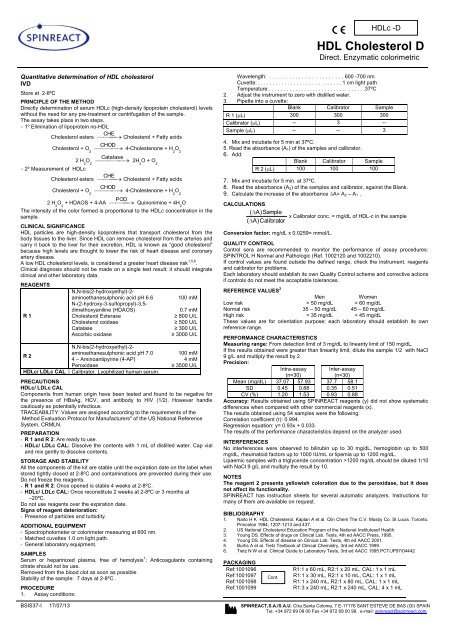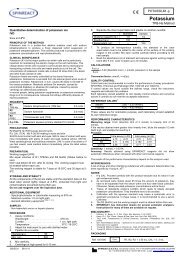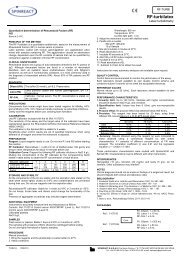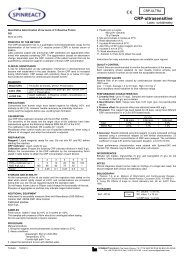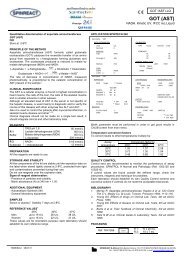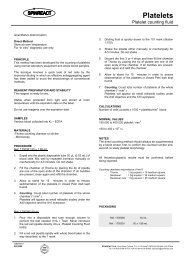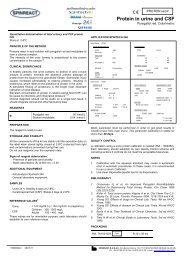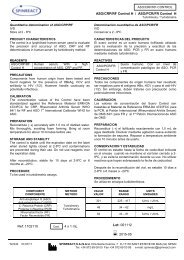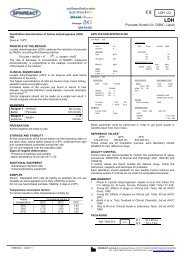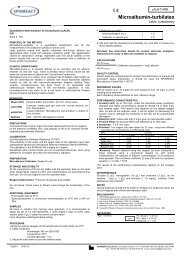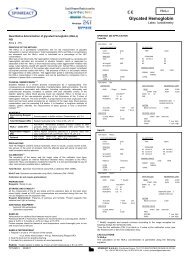HDL Cholesterol D
HDL Cholesterol D - Spinreact
HDL Cholesterol D - Spinreact
Create successful ePaper yourself
Turn your PDF publications into a flip-book with our unique Google optimized e-Paper software.
<strong>HDL</strong>c -D<br />
<strong>HDL</strong> <strong>Cholesterol</strong> D<br />
Direct. Enzymatic colorimetric<br />
Quantitative determination of <strong>HDL</strong> cholesterol<br />
IVD<br />
Store at 2-8ºC<br />
PRINCIPLE OF THE METHOD<br />
Directly determination of serum <strong>HDL</strong>c (high-density lipoprotein cholesterol) levels<br />
without the need for any pre-treatment or centrifugation of the sample.<br />
The assay takes place in two steps.<br />
1º Elimination of lipoprotein no-<strong>HDL</strong><br />
CHE<br />
<strong>Cholesterol</strong> esters<br />
<strong>Cholesterol</strong> + Fatty acids<br />
<strong>Cholesterol</strong> + O 2<br />
2º Measurement of <strong>HDL</strong>c<br />
<strong>Cholesterol</strong> esters<br />
<strong>Cholesterol</strong> + O 2<br />
CHOD<br />
2 H 2<br />
O 2<br />
Catalase<br />
2 H 2<br />
O 2<br />
+ HDAOS + 4-AA<br />
CHE<br />
CHOD<br />
POD<br />
4-Cholestenone + H 2<br />
O 2<br />
2H 2<br />
O + O 2<br />
<strong>Cholesterol</strong> + Fatty acids<br />
4-Cholestenone + H 2<br />
O 2<br />
Quinonimine + 4H 2<br />
O<br />
The intensity of the color formed is proportional to the <strong>HDL</strong>c concentration in the<br />
sample.<br />
CLINICAL SIGNIFICANCE<br />
<strong>HDL</strong> particles are high-density lipoproteins that transport cholesterol from the<br />
body tissues to the liver. Since <strong>HDL</strong> can remove cholesterol from the arteries and<br />
carry it back to the liver for their excretion, <strong>HDL</strong> is known as “good cholesterol”<br />
because high levels are thought to lower the risk of heart disease and coronary<br />
artery disease.<br />
A low <strong>HDL</strong> cholesterol levels, is considered a greater heart disease risk 1,5,6 .<br />
Clinical diagnosis should not be made on a single test result; it should integrate<br />
clinical and other laboratory data.<br />
REAGENTS<br />
R 1<br />
R 2<br />
<strong>HDL</strong>c/ LDLc CAL<br />
N,N-bis(2-hydroxyethyl)-2-<br />
aminoethanesulphonic acid pH 6.6<br />
N-(2-hydroxy-3-sulfopropyl)-3,5-<br />
dimethoxyaniline (HDAOS)<br />
<strong>Cholesterol</strong> Esterase<br />
<strong>Cholesterol</strong> oxidase<br />
Catalase<br />
Ascorbic oxidase<br />
N,N-bis(2-hydroxyethyl)-2-<br />
aminoethanesulphonic acid pH 7.0<br />
4 – Aminoantipyrine (4-AP)<br />
Peroxidase<br />
Calibrator. Lyophilized human serum.<br />
100 mM<br />
0.7 mM<br />
≥ 800 U/L<br />
≥ 500 U/L<br />
≥ 300 U/L<br />
≥ 3000 U/L<br />
100 mM<br />
4 mM<br />
≥ 3500 U/L<br />
PRECAUTIONS<br />
<strong>HDL</strong>c/ LDLc CAL<br />
Components from human origin have been tested and found to be negative for<br />
the presence of HBsAg, HCV, and antibody to HIV (1/2). However handle<br />
cautiously as potentially infectious.<br />
TRACEABILITY: Values are assigned according to the requirements of the<br />
Method Evaluation Protocol for Manufacturers" of the US National Reference<br />
System, CRMLN.<br />
PREPARATION<br />
- R 1 and R 2: Are ready to use.<br />
- <strong>HDL</strong>c/ LDLc CAL: Dissolve the contents with 1 mL of distilled water. Cap vial<br />
and mix gently to dissolve contents.<br />
STORAGE AND STABILITY<br />
All the components of the kit are stable until the expiration date on the label when<br />
stored tightly closed at 2-8ºC and contaminations are prevented during their use.<br />
Do not freeze the reagents.<br />
- R 1 and R 2: Once opened is stable 4 weeks at 2-8ºC.<br />
- <strong>HDL</strong>c/ LDLc CAL: Once reconstitute 2 weeks at 2-8ºC or 3 months at<br />
–20ºC.<br />
Do not use reagents over the expiration date.<br />
Signs of reagent deterioration:<br />
- Presence of particles and turbidity.<br />
ADDITIONAL EQUIPMENT<br />
- Spectrophotometer or colorimeter measuring at 600 nm.<br />
- Matched cuvettes 1.0 cm light path.<br />
- General laboratory equipment.<br />
SAMPLES<br />
Serum or heparinized plasma, free of hemolysis 1 : Anticoagulants containing<br />
citrate should not be use.<br />
Removed from the blood clot as soon as possible<br />
Stability of the sample: 7 days at 2-8ºC .<br />
PROCEDURE<br />
1. Assay conditions:<br />
Wavelength: . . . . . . . . . . . . . .. . . . . . . . . . . 600 -700 nm<br />
Cuvette: . . . . . . . . . . . . . . . . . . . . .. . .. . . . . 1 cm light path<br />
Temperature . . . . . . . . . . . . . . . . . . . . . . . . . .. . . . . . .37ºC<br />
2. Adjust the instrument to zero with distilled water.<br />
3. Pipette into a cuvette:<br />
Blank Calibrator Sample<br />
R 1 ( L) 300 300 300<br />
Calibrator ( L) -- 3 --<br />
Sample ( L) -- -- 3<br />
4. Mix and incubate for 5 min at 37ºC.<br />
5. Read the absorbance (A 1) of the samples and calibrator.<br />
6. Add:<br />
Blank Calibrator Sample<br />
R 2 ( L) 100 100 100<br />
7. Mix and incubate for 5 min. at 37ºC.<br />
8. Read the absorbance (A 2) of the samples and calibrator, against the Blank.<br />
9. Calculate the increase of the absorbance A= A 2 – A 1 .<br />
CALCULATIONS<br />
( A)Sample<br />
x Calibrator conc. = mg/dL of <strong>HDL</strong>-c in the sample<br />
( A)Calibrator<br />
Conversion factor: mg/dL x 0.0259= mmol/L.<br />
QUALITY CONTROL<br />
Control sera are recommended to monitor the performance of assay procedures:<br />
SPINTROL H Normal and Pathologic (Ref. 1002120 and 1002210).<br />
If control values are found outside the defined range, check the instrument, reagents<br />
and calibrator for problems.<br />
Each laboratory should establish its own Quality Control scheme and corrective actions<br />
if controls do not meet the acceptable tolerances.<br />
Men Women<br />
Low risk > 50 mg/dL > 60 mg/dL<br />
Normal risk 35 – 50 mg/dL 45 – 60 mg/dL<br />
High risk < 35 mg/dL < 45 mg/dL<br />
These values are for orientation purpose; each laboratory should establish its own<br />
reference range.<br />
PERFORMANCE CHARACTERISTICS<br />
Measuring range: From detection limit of 3 mg/dL to linearity limit of 150 mg/dL.<br />
If the results obtained were greater than linearity limit, dilute the sample 1/2 with NaCl<br />
9 g/L and multiply the result by 2.<br />
Precision:<br />
Intra-assay Inter-assay<br />
(n=30)<br />
(n=30)<br />
Mean (mg/dL) 37.07 57.93 37.7 58.1<br />
SD 0.45 0.88 0.35 0.51<br />
CV (%) 1.20 1.53 0.93 0.88<br />
Accuracy: Results obtained using SPINREACT reagents (y) did not show systematic<br />
differences when compared with other commercial reagents (x).<br />
The results obtained using 54 samples were the following:<br />
Correlation coefficient (r): 0.994.<br />
Regression equation: y= 0.93x + 0.033.<br />
The results of the performance characteristics depend on the analyzer used.<br />
INTERFERENCES<br />
No interferences were observed to bilirubin up to 30 mg/dL, hemoglobin up to 500<br />
mg/dL, rheumatoid factors up to 1000 IU/mL or lipemia up to 1200 mg/dL.<br />
Lipaemic samples with a triglyceride concentration >1200 mg/dL should be diluted 1/10<br />
with NaCl 9 g/L and multiply the result by 10.<br />
NOTES<br />
The reagent 2 presents yellowish coloration due to the peroxidase, but it does<br />
not affect its functionality.<br />
SPINREACT has instruction sheets for several automatic analyzers. Instructions for<br />
many of them are available on request.<br />
BIBLIOGRAPHY<br />
1. Naito H K <strong>HDL</strong> <strong>Cholesterol</strong>. Kaplan A et al. Clin Chem The C.V. Mosby Co. St Louis. Toronto.<br />
Princeton 1984; 1207-1213 and 437.<br />
2. US National <strong>Cholesterol</strong> Education Program of the National Institutesof Health.<br />
3. Young DS. Effects of drugs on Clinical Lab. Tests, 4th ed AACC Press, 1995.<br />
4. Young DS. Effects of disease on Clinical Lab. Tests, 4th ed AACC 2001.<br />
5. Burtis A et al. Tietz Textbook of Clinical Chemistry, 3rd ed AACC 1999.<br />
6. Tietz N W et al. Clinical Guide to Laboratory Tests, 3rd ed AACC 1995.PCT/JP97/04442<br />
PACKAGING<br />
Ref:1001096<br />
Ref:1001097<br />
Ref:1001098<br />
Ref:1001099<br />
Cont.<br />
.<br />
R1:1 x 60 mL, R2:1 x 20 mL, CAL: 1 x 1 mL<br />
R1:1 x 30 mL, R2:1 x 10 mL, CAL: 1 x 1 mL<br />
R1:1 x 240 mL, R2:1 x 80 mL, CAL: 1 x 1 mL<br />
R1:3 x 240 mL, R2:1 x 240 mL, CAL: 4 x 1 mL<br />
BSIS37-I 17/07/13 SPINREACT,S.A./S.A.U. Ctra.Santa Coloma, 7 E-17176 SANT ESTEVE DE BAS (GI) SPAIN<br />
Tel. +34 972 69 08 00 Fax +34 972 69 00 99. e-mail: spinreact@spinreact.com
<strong>HDL</strong>c -D<br />
<strong>HDL</strong> Colesterol D<br />
Directo. Enzimático colorimétrico<br />
Determinación cuantitativa de colesterol <strong>HDL</strong><br />
IVD<br />
Conservar a 2-8ºC<br />
PRINCIPIO DEL MÉTODO<br />
Determinación directa del <strong>HDL</strong>c (colesterol de lipoproteínas de alta densidad)<br />
sin necesidad de pre-tratamiento o centrifugado de la muestra.<br />
La determinación se realiza en dos pasos:<br />
1º Eliminación de lipoproteínas no-<strong>HDL</strong><br />
CHE<br />
Ésteres colesterol<br />
Colesterol + Ácidos grasos<br />
Colesterol + O 2<br />
2º Medición de <strong>HDL</strong>c<br />
Ésteres colesterol<br />
Colesterol + O 2<br />
CHOD<br />
2 H 2<br />
O 2<br />
Catalasa<br />
2 H 2<br />
O 2<br />
+ HDAOS + 4-AA<br />
CHE<br />
CHOD<br />
4-Colestenona + H 2<br />
O 2<br />
2H 2<br />
O + O 2<br />
Colesterol + Ácidos grasos<br />
POD<br />
4-Colestenona + H 2<br />
O 2<br />
Quinonimina + 4H 2<br />
O<br />
La intensidad del color formado es proporcional a la concentración de <strong>HDL</strong>c<br />
presente en la muestra ensayada.<br />
SIGNIFICADO CLÍNICO<br />
Las partículas de <strong>HDL</strong> son lipoproteínas de alta densidad que transportan el<br />
colesterol desde los tejidos del cuerpo hasta el hígado. Debido a que las <strong>HDL</strong><br />
pueden retirar el colesterol de las arterias y transportarlo de vuelta al hígado<br />
para su excreción, se les conoce como el colesterol o ‘lipoproteína buena’, ya<br />
que niveles elevados están relacionados con un menor riesgo cardiovascular.<br />
Un nivel bajo de colesterol <strong>HDL</strong> es considerado uno de los principales factores<br />
de riesgo cardiovascular y enfermedades de las arterias coronarias 1,5,6 .<br />
El diagnóstico clínico debe realizarse teniendo en cuenta todos los datos<br />
clínicos y de laboratorio.<br />
REACTIVOS<br />
R 1<br />
R 2<br />
<strong>HDL</strong>c/ LDLc CAL<br />
N,N-bis (2-hidroxietil)-2-<br />
aminoetanosulfonico acido pH 6.6<br />
N-(2-hidroxi-3-sulfopropil)-3,5-<br />
dimetoxianilina (HDAOS)<br />
Colesterol esterasa<br />
Colesterol oxidasa<br />
Catalasa<br />
Ascórbico oxidasa<br />
N,N-bis (2-hidroxietil)-2-<br />
aminoetanosulfonico acido pH 7,0<br />
4 – Aminoantipirina<br />
Peroxidasa<br />
Calibrador. Suero humano liofilizado.<br />
100 mM<br />
0.7 mM<br />
≥800 U/L<br />
≥ 500U/L<br />
≥300 U/L<br />
≥3000 U/L<br />
100 mM<br />
4 mM<br />
≥ 3500 U/L<br />
PRECAUCIONES<br />
<strong>HDL</strong>c/ LDLc CAL<br />
Los componentes de origen humano han resultado ser negativos para el<br />
antígeno HBs, HCV y para el anti-HIV (1/2). Sin embargo, deben tratarse con<br />
precaución como potencialmente infecciosos.<br />
TRAZABILIDAD: Los valores se asignan de acuerdo a los requisitos del<br />
Protocolo del Método de Evaluación US National Reference System CRMLN.<br />
PREPARACIÓN<br />
- R 1 y R 2: Listos para su uso.<br />
- <strong>HDL</strong>c/ LDLc CAL: Reconstituir el contenido de un vial con 1 mL de agua<br />
destilada. Tapar el vial y mezclar suavemente hasta disolver su contenido.<br />
CONSERVACIÓN Y ESTABILIDAD<br />
Todos los componentes del kit son estables hasta la fecha de caducidad<br />
indicada en la etiqueta del vial, cuando se mantienen los viales bien cerrados a<br />
2-8ºC, protegidos de la luz y se evita la contaminación. No congelar lor<br />
reactivos.<br />
- R 1 y R 2: Una vez abiertos son estables 4 semanas a 2-8ºC.<br />
- <strong>HDL</strong>c/ LDLc CAL: Una vez reconstituido es estable 2 semanas a 2-8ºC o 3<br />
meses a –20ºC.<br />
No usar reactivos fuera de la fecha indicada.<br />
Indicadores de deterioro de los reactivos:<br />
- Presencia de partículas y turbidez.<br />
MATERIAL ADICIONAL<br />
- Espectrofotómetro o analizador con cubeta para lecturas a 600 nm.<br />
- Cubetas de 1,0 cm de paso de luz.<br />
- Equipamiento habitual de laboratorio.<br />
MUESTRAS<br />
Suero o plasma: 1 No usar anticoagulantes con citrato.<br />
No utilizar muestras hemolizadas. Separar el suero de los hematies lo antes<br />
posible. Estabilidad de la muestra: 7 días a 2-8ºC.<br />
PROCEDIMIENTO<br />
1. Condiciones del ensayo:<br />
Longitud de onda: . . . . . . . . . . . . . . . . . . . . . 600-700 nm<br />
Cubeta:. . . . . . . . . . . . . . . . . . . . . . . . . . . 1 cm paso de luz<br />
Temperatura . . . . . . . . . . . . . . . . . . . . . . . . . . . .. . . . .37ºC<br />
2. Ajustar el espectrofotómetro a cero frente a agua destilada.<br />
3. Pipetear en una cubeta:<br />
Blanco Calibrador Muestra<br />
R 1 ( L) 300 300 300<br />
Calibrador ( L) -- 3 --<br />
Muestra ( L) -- -- 3<br />
4. Mezclar e incubar 5 min a 37ºC<br />
5. Leer la absorbancia (A 1) del calibrador y la muestra.<br />
6. Añadir:<br />
Blanco Calibrador Muestra<br />
R 2 ( L) 100 100 100<br />
7. Mezclar e incubar 5 minutos a 37ºC.<br />
8. Leer la absorbancia (A 2) frente al Blanco de reactivo.<br />
9. Calcular: A= A 2 – A 1 .<br />
CÁLCULOS<br />
( A)Muestra<br />
x Conc. Calibrador = mg/dL de <strong>HDL</strong> colesterol en la muestra<br />
( A)Calibrador<br />
Factor de conversión: mg/dL x 0,0259 = mmol/L.<br />
CONTROL DE CALIDAD<br />
Es conveniente analizar junto con las muestras sueros control valorados:<br />
SPINTROL H Normal y Patológico (Ref. 1002120 y 1002210).<br />
Si los valores hallados se encuentran fuera del rango de tolerancia, revisar el<br />
instrumento, los reactivos y el calibrador.<br />
Cada laboratorio debe disponer su propio Control de Calidad y establecer<br />
correcciones en el caso de que los controles no cumplan con las tolerancias.<br />
Hombres Mujeres<br />
Riesgo menor > 50 mg/dL > 60 mg/dL<br />
Riesgo normal 35 – 50 mg/dL 45 – 60 mg/dL<br />
Riesgo elevado < 35 mg/dL < 45 mg/dL<br />
Estos valores son orientativos. Es recomendable que cada laboratorio<br />
establezca sus propios valores de referencia.<br />
CARACTERÍSTICAS DEL MÉTODO<br />
Rango de medida: Desde el límite de detección de 3mg/dL hasta el límite de<br />
linealidad de 150 mg/dL.<br />
Si la concentración de la muestra es superior al límite de linealidad, diluir 1/2 con ClNa<br />
9 g/L y multiplicar el resultado final por 2.<br />
Precisión:<br />
Intraserie<br />
(n=30)<br />
Interserie<br />
(n=30)<br />
Media (mg/dL) 37.07 57.93 37.7 58.1<br />
SD 0.45 0.88 0.35 0.51<br />
CV (%) 1.20 1.53 0.93 0.88<br />
Exactitud: Los reactivos SPINREACT (y) no muestran diferencias sistemáticas<br />
significativas cuando se comparan con otros reactivos comerciales (x).<br />
Los resultados obtenidos con 54 muestras fueron los siguientes:<br />
Coeficiente de correlación (r): 0,994.<br />
Ecuación de la recta de regresión: y= 0,93x + 0.033.<br />
Las características del método pueden variar según el analizador utilizado.<br />
INTERFERENCIAS<br />
No se han observado interferencias con Bilirrubina hasta 30 mg/dL, hemoglobina<br />
hasta 500 mg/dL factores reumatoides hasta 1000 UI/mL o lipemia hasta 1200 mg/dL.<br />
Muestras lipémicas con concentración de triglicéridos mayor a 1200 mg/dL, se deben<br />
diluir 1/10 con ClNa 9 g/L y multiplicar el resultado final por 10.<br />
NOTAS<br />
El reactivo 2 presenta coloración amarillenta debido a la peroxidasa que<br />
contiene, lo cual no afecta en absoluto la funcionalidad del reactivo.<br />
SPINREACT dispone de instrucciones detalladas para la aplicación de este reactivo<br />
en distintos analizadores.<br />
BIBLIOGRAFÍA<br />
1. Naito H K <strong>HDL</strong> <strong>Cholesterol</strong>. Kaplan A et al. Clin Chem The C.V. Mosby Co. St Louis. Toronto.<br />
Princeton 1984; 1207-1213 and 437.<br />
2. US National <strong>Cholesterol</strong> Education Program of the National Institutesof Health.<br />
3. Young DS. Effects of drugs on Clinical Lab. Tests, 4th ed AACC Press, 1995.<br />
4. Young DS. Effects of disease on Clinical Lab. Tests, 4th ed AACC 2001.<br />
5. Burtis A et al. Tietz Textbook of Clinical Chemistry, 3rd ed AACC 1999.<br />
6. Tietz N W et al. Clinical Guide to Laboratory Tests, 3rd ed AACC 1995.PCT/JP97/04442<br />
PRESENTACIÓN<br />
Ref:1001096<br />
Ref:1001097 Cont.<br />
Ref:1001098 .<br />
Ref:1001099<br />
R1:1 x 60 mL, R2:1 x 20 mL, CAL: 1 x 1 mL<br />
R1:1 x 30 mL, R2:1 x 10 mL, CAL: 1 x 1 mL<br />
R1:1 x 240 mL, R2:1 x 80 mL, CAL: 1 x 1 mL<br />
R1:3 x 240 mL, R2:1 x 240 mL, CAL: 4 x 1 mL<br />
BSIS37-E 17/07/13 SPINREACT,S.A./S.A.U. Ctra.Santa Coloma, 7 E-17176 SANT ESTEVE DE BAS (GI) SPAIN<br />
Tel. +34 972 69 08 00 Fax +34 972 69 00 99. e-mail: spinreact@spinreact.com


